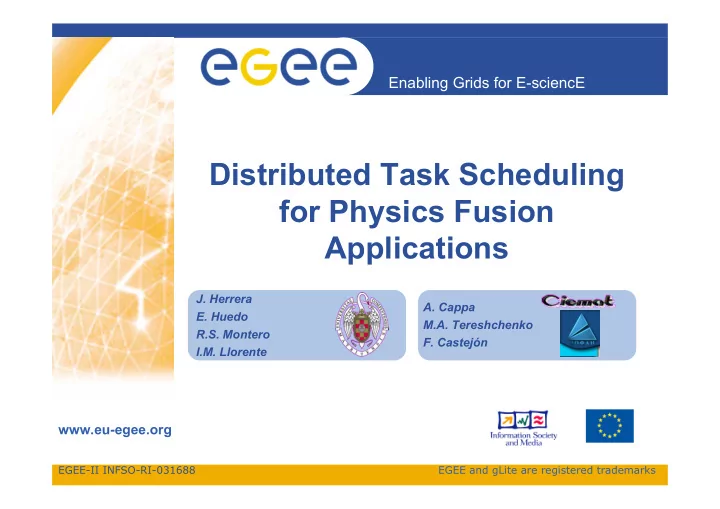

Enabling Grids for E-sciencE Distributed Task Scheduling for Physics Fusion Applications J. Herrera A. Cappa E. Huedo M.A. Tereshchenko R.S. Montero F. Castejón I.M. Llorente www.eu-egee.org EGEE-II INFSO-RI-031688 EGEE and gLite are registered trademarks
Index Enabling Grids for E-sciencE • Self-schedulers Algorithms • Grid Trapezoid Self-Scheduler • MARATRA • Results • Conclusion EGEE-II INFSO-RI-031688 2
Self-Schuler Algorithms Enabling Grids for E-sciencE • Static Algorithms – The chunk size is fixed in compile-time – Advantages: Minimum scheduling overhead – Disadvantages: Load imbalance • Dynamic Algorithms – The chunk size is adjusted in execution time – The most important algorithms: � CSS � GSS � TSS � FSS � FISS – Advantages: A good load balance – Disadvantages: No suitable to distributed environments EGEE-II INFSO-RI-031688 3
Self-Schuler Algorithms Enabling Grids for E-sciencE • Distributed Algorithms – Node characteristics: cpu speed, memory size, etc – More important algorithms: � DTSS � DFSS � DFISS � DTFSS – Advantages: Suitable to heterogeneous cluster – Disadvantages: Not fixed to Grid environments EGEE-II INFSO-RI-031688 4
Grid Trapezoid Self-Scheduler Enabling Grids for E-sciencE • Main characteristics: – Grid characteristics: a high degree of heterogeneity, high fault rate, dynamic resource availability, etc. – Distributed and dynamic algorithm – Better workload balancing between all Grid resources – Decrease of the scheduling overhead – Transparent from the user point of view • Three pillars: – Grid Benchmarking Model – User statistics – Trapezoid Self-scheduler (TSS) EGEE-II INFSO-RI-031688 5
Grid Benchmarking Model Enabling Grids for E-sciencE • Provides a way to investigate performance properties of Grid environments • Two main parameters: – Asymptotic performance (r � ) : the maximum rate of performance in task executed per second – Half-performance length (n 1/2 ) : the number of task required to obtain the half of asymptotic performance • 2 x n 1/2 � testbed equivalent nodes number EGEE-II INFSO-RI-031688 6
Grid Benchmarking Model Enabling Grids for E-sciencE EGEE-II INFSO-RI-031688 7
Grid Benchmarking Model Enabling Grids for E-sciencE EGEE-II INFSO-RI-031688 8
R max (i) Enabling Grids for E-sciencE • The execution time ratio factor between the faster node and the i node • User execution statistics • Ordered ranking (by time execution) of all testbed nodes • GridTrapezoid Self-Scheduler uses R max (i) and n 1/2 to obtain the first chunk size based on TSS scheduler EGEE-II INFSO-RI-031688 9
MARATRA Enabling Grids for E-sciencE • MAssive RAy TRAcing in Fusion Plasmas • Parameter Sweep Application • Executable: – Truba (traces 1 ray of the microwave bunch) – 1.8 MB – 9' (Pentium 4 3.20 Ghz) – Input files =~ 70 KB – Output files =~ 549 KB • Cluster Environment: – 2 x 10 3 rays factor – 5 sites (higher, medium1, medium2, medium-lower, lower) – 10 nodes per site – Experiments with: CSS(40), GSS, TSS, GTSS , FSS, FISS EGEE-II INFSO-RI-031688 10
Experiment Wall Time Enabling Grids for E-sciencE EGEE-II INFSO-RI-031688 11
Load Balance Enabling Grids for E-sciencE EGEE-II INFSO-RI-031688 12
Conclusion Enabling Grids for E-sciencE • New Self-scheduler algorithm – Distributed and dynamic – Transparent from the user point of view – Adaptative – Grid characteristics • MARATRA experiment • Decrease of wall time execution • Load balance between all grid nodes • Scheduling overhead reduction EGEE-II INFSO-RI-031688 13
Future work Enabling Grids for E-sciencE • Increase the problem size – Objective: 10 4 and 10 5 • Add GTSS to Grid W ay metascheduler EGEE-II INFSO-RI-031688 14
Enabling Grids for E-sciencE Distributed Task Scheduling for Physics Fusion Applications J. Herrera A. Cappa E. Huedo M.A. Tereshchenko R.S. Montero F. Castejón I.M. Llorente www.eu-egee.org EGEE-II INFSO-RI-031688 EGEE and gLite are registered trademarks
Recommend
More recommend